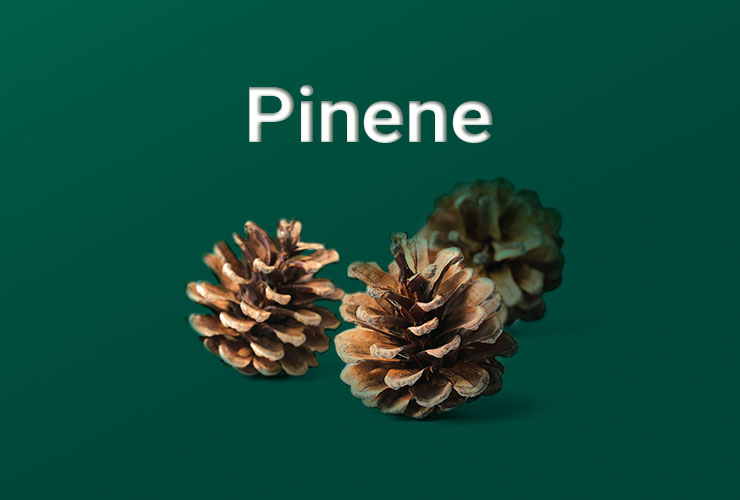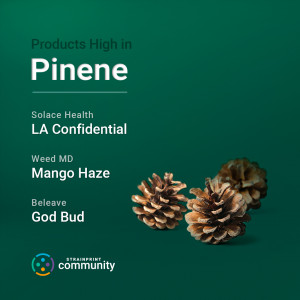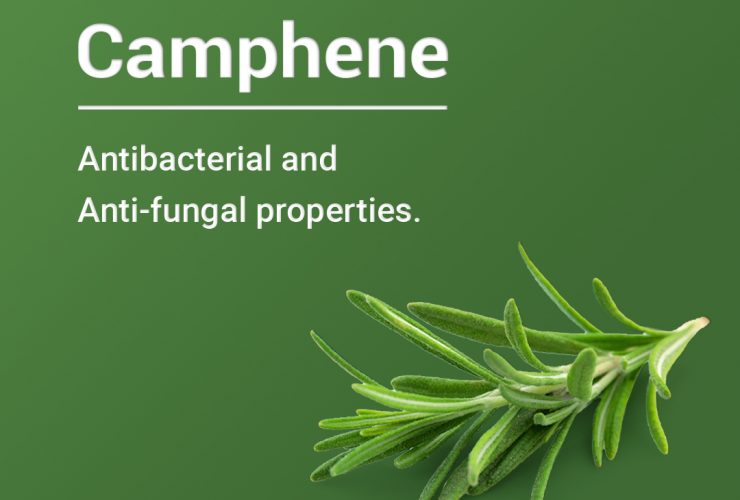Understanding Terpenes: Pinene

Written by
Welcome to the Strainprint Community Understanding Terpenes Series. This collection of text articles focuses on providing patients with a better understanding of the medical benefits of terpenes, the group of 200 molecules produced by the cannabis herb that have been shown to provide a wide range of efficacies, including analgesic and anti-inflammatory properties of value in the treatment of literally hundreds of diseases and conditions.
Terpenes Defined
Before diving into the details behind pinene, the terpene produced by cannabis known for its anti-inflammatory, bronchodilation, and anti-cancer powers, it behooves readers to develop a solid understanding of terpenes as a category of wellness molecule. Patients gain advantage by knowing how terpenes compare to the other group of healthy chemicals produced by cannabis called cannabinoids (including tetrahydrocannabinol [THC] and cannabidiol [CBD]).
More than 20,000 varieties of terpenes exist throughout nature. The interesting part of the evolution of these odiferous chemicals is that they are shared among different plant species. For example, the terpene linalool—which conveys an aroma of lavender and is present in hundreds of strains of cannabis—is also produced by more than 200 other plants, including lilacs and a variety of herbs and mints.
Terpenes were once thought to deliver nothing more than an enticing aroma to thousands of plants, from cannabis to conifers and lavender to lilacs. From an evolutionary perspective, terpenes help to protect plants from pests and predators with their intense fragrance, acting as a reserve siren song. Within the past couple of decades, however, researchers have learned that terpenes offer medical benefits to all mammals that rival those of their chemical cousins the cannabinoids.
Terpenes constitute approximately 10-20 percent of total pre-smoked resin produced by the nearly microscopic trichome glands of the mature female plants. It is estimated that 10-30 percent of the smoke resulting from the combustion of cannabis flowers is from terpenes.
According to Leafly, “Terpenes play a key role in differentiating the effects of various cannabis strains. Some terpenes promote relaxation and stress-relief, while others promote focus and acuity.”
Loosely speaking, the three primary efficacy benefits of terpenes are their ability to fight pain, the way they reduce systemic inflammation, and their seemingly magical capability to reduce anxiety. Depending on the specific terpene cited, a plethora of other primary and secondary benefits exist, including anti-fungal and anti-bacterial properties.
Entourage Effect + Dr. Ethan Russo
It must be stressed that the theoretical efficacy of an individual terpene, such as myrcene, is confounded by the fact that it is typically consumed in tandem with other terpenes and cannabinoids (including flavonoids, which will be covered in a future Strainprint Community article).
This is especially true for patients who gravitate toward “full spectrum” and “whole plant” products. This issue is addressed by a theory called the entourage effect, the term coined by Dr. Ethan Russo, M.D., a California-based neurologist and one of the pioneers in the field of cannabinoid and terpene research for medical applications.
In 2011, Russo published a research study entitled “Taming THC: Potential Cannabis Synergy and Phytocannabinoid-terpenoid Entourage Effects” in the British Journal of Pharmacology. He and his team studied the terpenes a-pinene, b-caryophyllene, caryophyllene oxide, limonene, linalool, myrcene, nerolidol, and phytol.
In his pinnacle study, Russo explains how cannabinoids and terpenes intermingle in the human body to modify the effects of one another and, in essence, create an overall different, or “greater,” efficacy based on the exact molecules present and, of equal importance, the ratios in which they appear.
Examples of this intricate mechanism revealed by the study include myrcene’s ability to reduce the selectivity of the blood-brain barrier, allowing molecules like THC and CBD to pass this biological filter more easily and in greater quantities. While myrcene illustrates how a terpene can amplify, or boost, a cannabinoid, the terpene pinene has been shown to buffer THC by reducing the cognition and memory impairment that sometimes accompanies the infamous psychoactive molecule.
Russo’s research also demonstrated that a combination of caryophyllene, myrcene, and pinene is helpful for reducing and treating anxiety (more than 100 million Americans suffer from the most common form, social anxiety).
Likewise, the study revealed that a combination of the terpenes limonene and linalool and the cannabinoid cannabigerol (CBG) is helpful in treating MRSA (methicillin-resistant staphylococcus aureus), the most treatment-resistant form of staph infection. CBD, limonene, and linalool have been investigated for their ability to fight acne and treat other skin conditions, including eczema and psoriasis. When combined with THC, the cannabinoid cannabinol (CBN) produces an enhanced sedative effect.
The pioneering Russo study concluded multiple beneficial interactions between myrcene and several major cannabinoids, including THC and CBD.
-
CBD + myrcene: Decreases inflammation, fights cancer, reduces pain.
-
CBG + myrcene: Anti-cancer.
-
THC + myrcene: Analgesic (reduces pain) and muscle relaxant; enhanced sedative and tranquilization benefits.
Understanding Pinene
Pinene, one of the most researched and documented terpenes found in cannabis, is available in two varieties: Alpha-pinene (sometimes denoted as α-pinene) and beta-pinene (β-pinene).
The alpha type carries a scent of pine needles and rosemary; beta-pinene conveys an aroma of basil, dill, hops, and parsley. The alpha variety is significantly more common in the cannabis herb and typically the variant being referenced if no distinction between the two is provided.
Pinene is the most common terpene in the plant world and produced in significant quantities by basil, cedar, conifer trees, dill, eucalyptus, oranges (mostly the rind), parsley, pine trees (mostly the needles), rosemary, and literally hundreds of other plants. It is even present in turpentine, which has been employed for thousands of years as a detergent, medicine, and paint solvent. This makes sense, however, given that turpentine is distilled from pine trees.
Strains rich in pinene span the sativa-indica continuum and include Blue Dream (sativa-dominant), Bubba Kush (indica), ChemDawg (hybrid), Dutch Treat (indica-dominant), God Bud from Beleave, Jack Herer (sativa-dominant), LA Confidential from Solace Health, Island Sweet Skunk (sativa), OG Kush (hybrid/debated), Romulan (indica), Mango Haze from WeedMD, Strawberry Cough (sativa), and Trainwreck (sativa).

Medicinal Efficacy
Pinene’s most pronounced medicinal efficacy is its power to deliver mental focus and energy. Ironically, it also helps asthmatics and patients who suffer lung conditions based on its role as a bronchodilator, meaning it improves airflow to the lungs. It is also an anti-inflammatory, making it of note for a variety of diseases and conditions involving inflammation, including arthritis and fibromyalgia. Pinene has also been used as an effective ingredient in topical antiseptics.
This terpene has also been found to counter the short-term memory loss associated with the infamous psychoactive cannabinoid tetrahydrocannabinol (THC), making it a potential ingredient in a wide range of cannabis products. One of the most promising areas of pinene’s efficacy, however, is against cancer, a disease that resulted in more than 1.7 million new cases and killed more than 600,000 people in the United States alone in 2018.
The Studies
Several studies have focused on various aspects of the efficacy provided by the terpene pinene for many conditions, from cancer and pain to depression and epilepsy.
A study published in 2013 entitled “Antioxidative, Anticancer, and Genotoxic Properties of α-pinene on N2a Neuroblastoma Cells” published in Biologia (a medical journal regarding cellular and molecular biology) revealed that pinene reduced cancer tumor size. “Overall our results suggest that α-pinene is of a limited therapeutic use as an anticancer agent,” concluded the researchers.
A 2011 study conducted by Russo and published in the British Journal of Pharmacology noted the anti-inflammatory properties of alpha-pinene and potential efficacy for inflammation-based patients, including those suffering arthritis, cancer, and Crohn’s. “It is anti‐inflammatory and is a bronchodilator in humans at low exposure levels,” reported the researchers, adding “Beyond this, it seems to be a broad‐spectrum antibiotic.”
Another study from 2011 entitled “Comparative Anti-infectious Bronchitis Virus (IBV) Activity of Pinene” that was published in the Swiss journal Molecules. The researchers found that both variants of pinene may be valuable for a variety of patients. “Results presented here may suggest that α-pinene and β-pinene possess anti-IBV properties and therefore are a potential source of anti-IBV ingredients for the pharmaceutical industry,” concluded the study.
A study published in the journal Inhalation Toxicology in 2002 and entitled “Upper Airway and Pulmonary Effects of Oxidation Products of Alpha-pinene, D-limonene, and Isoprene” provided evidence for the effectiveness of pinene as an effective bronchodilator, making it of value to patients with asthma and other lung conditions.


